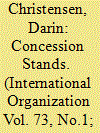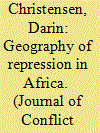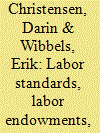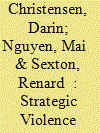|
|
|
Sort Order |
|
|
|
Items / Page
|
|
|
|
|
|
|
| Srl | Item |
| 1 |
ID:
165159


|
|
|
|
|
| Summary/Abstract |
Foreign investment in Africa's mineral resources has increased dramatically. This paper addresses three questions raised by this trend: do commercial mining investments increase the likelihood of social or armed conflict? If so, when are these disputes most prevalent? And, finally, what mechanisms help explain these conflicts? I show, first, that mining has contrasting effects on social and armed conflict: while the probability of protests or riots increases (roughly doubling) after mining starts, there is no increase in rebel activity. Second, I show that the probability of social conflict rises with plausibly exogenous increases in world commodity prices. Finally, I compile additional geo-spatial and survey data to explore potential mechanisms, including reporting bias, environmental harm, in-migration, inequality, and governance. Finding little evidence consistent with these accounts, I develop an explanation related to incomplete information—a common cause of conflict in industrial and international relations. This mechanism rationalizes why mining induces protest, why these conflicts are exacerbated by rising prices, and why transparency dampens the relationship between prices and protest.
|
|
|
|
|
|
|
|
|
|
|
|
|
|
|
|
| 2 |
ID:
160788


|
|
|
|
|
| Summary/Abstract |
I ask how the location of a protest affects how forcefully governments crack down. This geography of repression provides insight into a larger strategic problem: under what conditions do leaders meet protests with violence? I argue that protests in rural areas pose a smaller threat and, thus, prompt less frequent intervention. However, when governments decide to repress rural protests, they are less concerned that lethal repression might incite a backlash, as there are fewer bystanders in more rural areas that can join the fray. I uncover two patterns consistent with this theory: (1) repression is 30 percent more frequent in response to social conflicts in urban areas; but (2), if the state does employ repression, it is 75 percent more likely to kill dissidents in rural areas. The empirical relationships I report cannot be explained by reporting bias, international sanctioning, proximity to past armed conflicts, or the presence of natural resources.
|
|
|
|
|
|
|
|
|
|
|
|
|
|
|
|
| 3 |
ID:
133652


|
|
|
|
|
| Publication |
2014.
|
| Summary/Abstract |
Proponents often recommend high labor standards as a means of reducing inequality between and within countries. Opponents suggest that labor standards exacerbate international and domestic inequalities. In this paper, we forward a simple argument whereby the impact of higher labor standards on domestic inequality depends on a country's labor endowment. We hypothesize that where labor is abundant, higher standards will exacerbate inequality. Where labor is scarce, higher labor standards might lower inequality. In both cases, the impact of labor standards on inequality work through an employment and wage effect. Using newly available data on labor standards around the world from 1981 to 2000, we provide evidence largely consistent with our hypotheses. Higher labor standards do, indeed, exacerbate inequality in labor-abundant economies. On the other hand, higher labor standards lower inequality in labor-scarce economies. We discuss the implications of these findings for work on labor market insiders and outsiders as well as the political economy of development.
|
|
|
|
|
|
|
|
|
|
|
|
|
|
|
|
| 4 |
ID:
181670


|
|
|
|
|
| Summary/Abstract |
We address a debate over the effects of private versus customary property rights on external investment. Despite political economists’ claims that external investors favor private property rights, other experts argue that customary systems enable large-scale “land grabs.” We organize these competing claims, highlighting trade-offs due to differences in legibility versus the ability to displace existing landholders under both systems. We study a natural experiment in Liberia, where law codifies parallel private and customary property rights systems. We use this institutional boundary and difference-in-differences methods to isolate differential changes in external investment under the different property rights systems following the global food crisis of 2007–08. We find a larger increase in land clearing where private property rights prevailed, with such clearing related to more concession activity. Qualitative study of a palm oil concession reveals challenges external investors confront when navigating customary systems.
|
|
|
|
|
|
|
|
|
|
|
|
|
|
|
|
| 5 |
ID:
165601


|
|
|
|
|
| Summary/Abstract |
Democratic transitions are often followed by conflict. This article explores one explanation: the military’s strategic use of violence to retain control of economically valuable regions. The authors uncover this dynamic in Myanmar, a country transitioning from four decades of military rule. Fearing that the new civilian government will assert authority over jade mining, the military initiated violence in mining townships. Using geocoded data on conflict and jade mines, the authors find evidence for this strategic use of violence. As Myanmar started to transition in 2011, conflicts instigated by the military in jademining areas sharply rose. The article also addresses alternative explanations, including a shift in the military’s strategy, colocation of mines and military headquarters, commodity prices, opposition to a controversial dam, and trends specific to Kachin State. With implications beyond Myanmar, the authors argue that outgoing generals can use instability to retain rents where plausible challengers to state authority provide a pretense for violence.
|
|
|
|
|
|
|
|
|
|
|
|
|
|
|
|
|
|
|
|
|